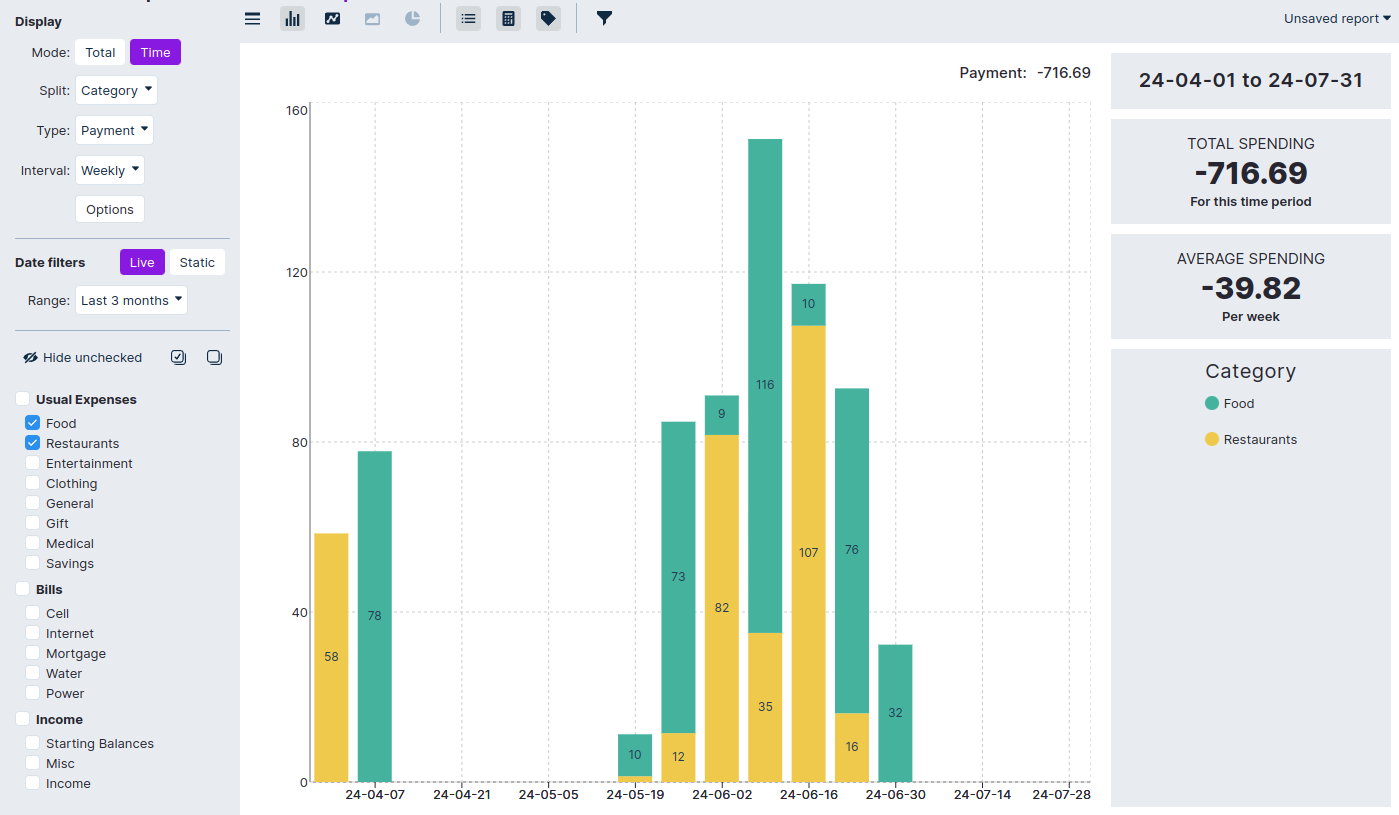Actual vs YNAB
Hello budgeters!
This is the start of the series Actual Versus! Today we will be comparing Actual Budget to YNAB (You Need a Budget).
YNAB is the longstanding heavyweight in the envelope budgeting space. It was one of the originals. Lets see how Actual stacks up!
Introduction
I will structure this comparison as follows. First I will go over some of the fundamentals individually, then at the end have a quick comparison of some of the smaller features. I will go in depth in the basics like how Actual is installed and run, how the budgeting basics compare, and then the other exciting features. Along with this blog post you can look around at our documentation, or our main feature list.
tl;dr
- Actual uses envelope budgeting, same as YNAB.
- Actual is free for the base app and all updates. Hosting or optional bank syncing may have a fee depending on how you set up Actual.
- Actual can run on all devices online or offline, and can sync between devices if you set up a sync server.
- Your data is yours if you use Actual Budget, where with YNAB you have no control over your data
Running the Applications
This may be the place were Actual and YNAB are the most different. YNAB is a service. This means that the user has minimal control over the application and data. This also means that YNAB owns your budget data. They say that they keep it safe, but that could change any time they want to. Because of this service model YNAB also has a continuing fee. Your budgets are not available offline since you need to access YNAB's web page to see your budget.
Actual is Free and Open-Source. This means that there is no cost for the core software (extras like bank syncing may have a fee from the provider). If you don't want to use bank syncing, or it is not available in your region, there is no cost! No cost to download, no cost to use, no cost for updates. You are also free to modify the application in any way you want.
Because Actual is not a service we never see your budget data. It is controlled by you and it lives entirely on your devices and your server if you host one. This makes the data available offline since it is always on your device.
How to run Actual
Actual has a few options for running the software. The easiest to start is to install the desktop application or try the web demo. Long term you should consider also hosting your own sync server. Considerations for the sync server are added below.
Desktop Application
The desktop application can be found at our github release page.
Download the file that matches your operating system.
The .exe for Windows, the .dmg for Mac, or one of the Linux options.
Web version
You can try out Actual using the web demo on any device. This link can be used long term if you are exclusively on mobile and don't have a sync server. The data will be stored on your device and we wont have any access to it. If you plan to do this make sure to export you data periodically as a backup (this can be done in the budget settings). The web version can be installed as an app for offline use. This can be found in your browser settings when viewing the web page.
Sync Server
Actual has two parts: the client (the stuff you see and interact with), and an optional sync server. The server is what allows syncing your budget file between devices and allows for bank syncing. A full list of what does and does not require the sync server can be found in this table. The docs page also includes information about options for hosting a sync server.
The quickest way to host a sync server is to use PikaPods. PikaPods is a hosting service that costs just over one dollar a month to host a personal sync server[^1]. This can be set up in minutes and provides a private sync server for your data, along with a copy of the web client for you to use on any device. Other options include hosting your own with docker or node.js, or using some other hosting service.
Core Feature Comparison
Budgeting
The core budgeting style is where Actual and YNAB are the most similar. Both use envelope style budgeting, sometimes referred to zero-sum budgeting. This means that all your funds are assigned to categories, or "jobs" in YNAB vernacular. The budgeting styles are so similar you can import your YNAB data into Actual and move on like almost nothing changed.
How accounts and transactions are handled is very similar. There are transactions with payees, notes, categories, etc. Just like you are used to.
Here is a snippet of what Actual looks like in the budgeting view. Its similar to YNAB, but each have a unique style.

Credit Cards
This is the one place where YNAB and Actual differ in budgeting. YNAB automagically handles credit cards for you. Some users prefer this approach while others find it annoying.
The way YNAB handles this can make it a bit too easy to hold onto credit card debt and let it build up. Actual needs some more deliberate handling of that debt. Our docs show how to do this in Actual. The tl;dr is that you put your existing debt in a category on your budget and any new debt has to be manually added into that category. Principal and interest payments, get categorized into this category. If you use credit cards, but don't carry any debt, then don't worry, you don't have to do anything special. Envelope budgeting handles that process natively by using funds budgeted in your categories and paying off your balance.
Reports
YNAB has a few simple reports but nothing especially exciting. On the other hand, Actual has built Net Worth and Cashflow reports and a full Custom Report engine for generating as many special purpose reports as you can think of. We have options for bar charts, line charts, area graphs, donut graphs, and data tables. These custom reports can be saved for later and get added to your personal report dashboard! All reports can be viewed on mobile.
Here is an example of the kind of granularity you can achieve with these custom reports.
This report is viewing how much was spent on food, by week, in both the Food and Restaurant categories over the last few months.

Bank Syncing
Actual currently has two bank sync providers with built in support.
For EU/UK users, Actual supports using Nordigen as a bank sync provider. It is free for banks and that market.
For North American banks, Actual has support for using SimpleFIN. This feature is still in an experimental state, but most users have had very good experiences with it. SimpleFIN costs $1.50 per month, or $15 per year (at time of writing).
For other bank sync providers and other markets Actual has a JS API that can be used to create custom imports. We also would be open to any contributions that add new providers!
Goals and Budget Automation
YNAB has revamped its targets in recent months. They are all a flavor of "save X funds every Y time period". This can cover many different situations pretty well. YNAB does also have indicator bars to show if the goal has been met, or progress towards that goal.
Actual currently is developing a feature that is similar to YNAB's targets we refer to as goal templates. Goal templates is more flexible and has more options than YNAB's targets. A full write up of how they work can be found in the Goal Templates Documentation. Some notable goals that Actual has would be: goals based on scheduled expenses, percentage goals, remainder goals, and much more!
One big difference from YNAB to Actual currently is that in Actual goals are indicated as met or not on a monthly basis instead of a total basis. This means that if you have a multi month goal to save $500 in the next 10 months, Actual would give you a met indication if you budget $50. If you budget more than you needed, the goal will adjust each month so that the amount you need in the current month is always accurate. Here is an example of what these indications looks like for a goal met(green), goal incomplete(yellow), or overspent(red) category.

These goals can also be used to automate your budgeting each month, same as YNAB. One extra feature that YNAB does not have with their goals is the ability to prioritize certain categories. This makes it so the goal templates can be used to budget everything automatically. There are a few blog posts about using these templates. One about budgeting all categories using priorities. And another for weekly based budgeting.
Goal templates is under active development so expect it to be even better as time goes on!
Other Features
This will be a rapid fire view of feature comparison. For a full view of these features you can read up in our documentation. Don't worry the docs aren't too long to read. I will also be including the already mentioned features.
| Feature | Actual | YNAB | Notes |
|---|---|---|---|
| Cost | FREE | $109/yr | The base application of Actual is free. This does not include if you choose to use a hosting service or bank sync provider |
| Works On All Devices | ✅ | ✅ | Actual is still in the process of reaching full feature parity between mobile and desktop, but it is nearly there |
| Desktop App | ✅ | ❌ | Actual includes automated backups in the desktop app |
| You Own Your Data | ✅ | ❌ | Actual can't see your data since it never leaves you devices or server |
| Offline Use | ✅ | ❌ | |
| Sync Between Devices | ✅ | ✅ | Requires a server for Actual to sync between devices, where YNAB has this out of the box |
| Envelope Budgeting | ✅ | ✅ | |
| Traditional Budgeting | ✅ | ❌ | Actual does have the option for a non-envelope style budget, but we think you should stick with envelope budgeting |
| Multiple budget files | ✅ | ✅ | |
| Dark Theme | ✅ | ✅ | Actual has two dark themes. A regular "Dark", and "Midnight" for those who love black |
| Scheduled Transactions | ✅ | ✅ | |
| Bank Sync | ✅ | ✅ | May not be free for Actual. YNAB only supports North America while Actual supports both North America and Europe and requires a sync server |
| Open Source | ✅ | ❌ | |
| Transaction Rules | ✅ | ✅ | YNAB is limited to just rules to modify the payee, while Actual's Rules can modify much more if desired |
| Custom Reports | ✅ | ❌ | |
| Flexible Goals | ✅ | ✅ | Actual has more options for Goals but less in the way of goal status indication |
Conclusion
I hope this comparison was useful to those considering the two budgeting apps. The two apps are different and have their own pros and cons.
If you would like a different perspective, from a recent YNAB user, check out this write up. It goes in depth on some of the differences between the two applications and some benefits, drawbacks, and considerations if someone were to migrate from YNAB to Actual.
[^1] A portion of the cost to host on PikaPods is donated to the Actual Budget Project. With that said, PikaPods is a very simple, and cost-effective way to host your server.
